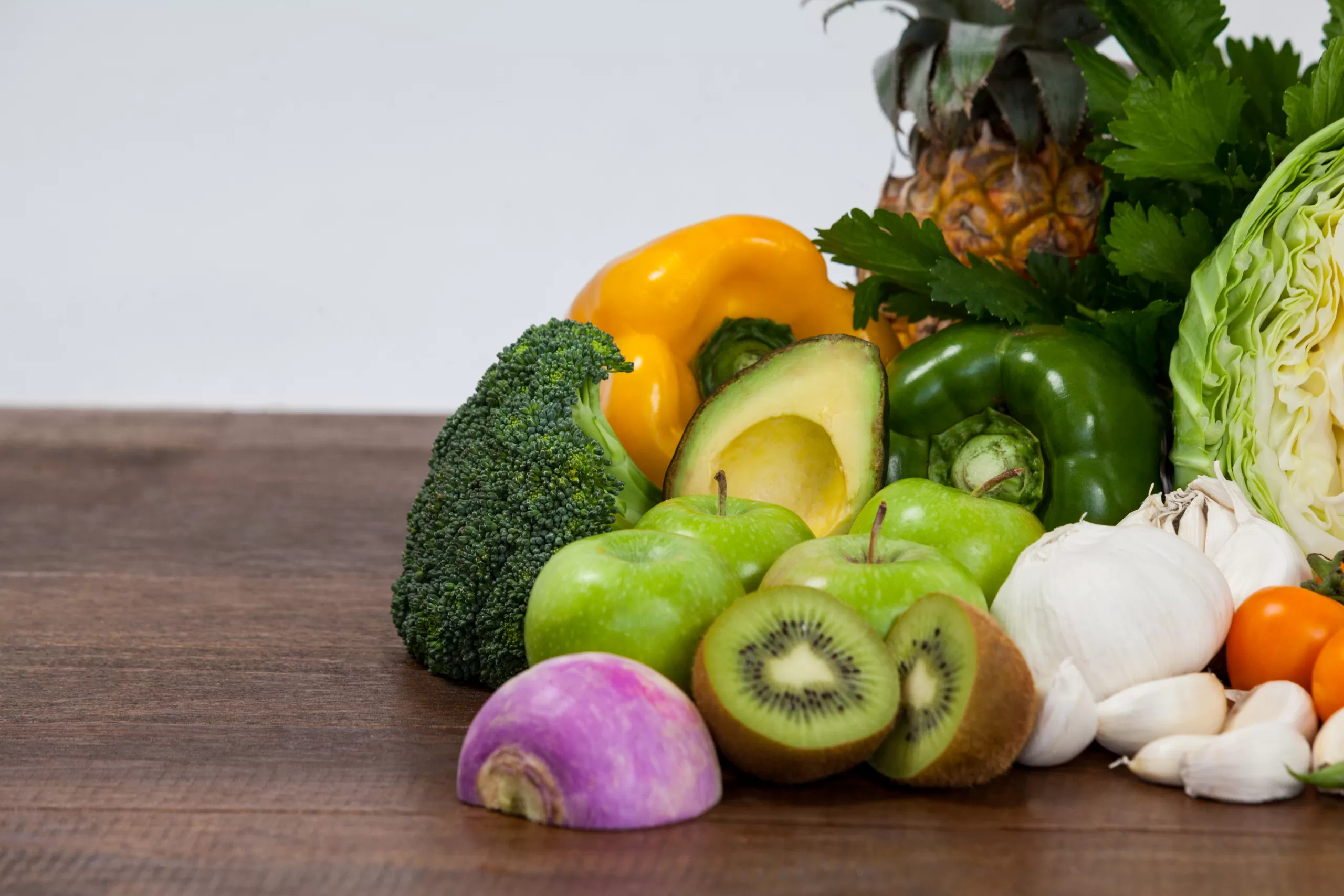What is an Athlete’s Diet?
An athlete’s diet is a scientifically designed nutrition plan crafted to support physical endurance, muscle recovery, and skin health. Athletes require a strategic balance of macronutrients—carbohydrates, proteins, and fats—along with targeted micronutrients that not only enhance performance but also help in maintaining radiant skin.
This diet relies on research-based insights to optimize how our body processes energy, sustains high-performance levels, and maintains skin vitality, making it ideal not only for athletes but also for anyone aiming to improve their fitness and skin quality.

How I Discovered the Secrets to Radiant Skin (And How You Can Too!)
Benefits of an Athlete’s Diet for Skin and Fitness
Enhanced Skin Glow and Health
- Why it Works: An athlete’s diet is typically rich in antioxidants, proteins, and essential fatty acids, which are all dermatologist-approved ingredients for healthy, glowing skin.
- Science Behind It: These nutrients work together to repair skin cells, reduce inflammation, and improve overall complexion.
Understanding Skin Health
While an athlete’s diet provides key nutrients, skin health is influenced by a multitude of factors:
- Genetics: Your genetic makeup plays a crucial role in determining skin type and susceptibility to conditions such as acne or eczema.
- Age: As we age, skin naturally loses elasticity and moisture, impacting its appearance and resilience.
- Hormone Levels: Fluctuations in hormones, especially during puberty, pregnancy, or menopause, can significantly affect skin condition.
- Medical Conditions: Conditions like diabetes can impair the skin’s ability to heal and maintain its natural barrier.
- Lifestyle Choices: Diet, hydration, and habits such as smoking or excessive sun exposure also contribute to skin health.
Incorporating a balanced approach that considers an athlete’s nutritional habits alongside these factors can optimize both skin health and overall wellness.
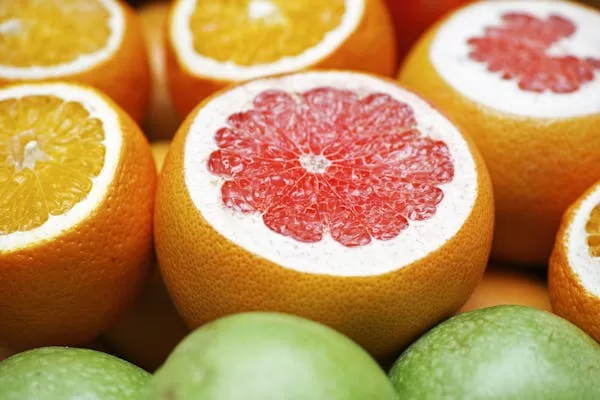
Top Tips for Eating Your Way to Glowing Skin
Achieving radiant skin isn’t just about what you apply on the outside; it begins with what you nourish your body with. Here are some expert-backed dietary tips to enhance your skin’s health:
1. Increase Fruit and Vegetable Intake
Aim for at least five servings of fruits and vegetables daily. These foods are rich in antioxidants, which protect your skin from cellular damage. Vibrant colors like orange and green indicate the presence of skin-friendly nutrients such as beta-carotene and lutein. Fill your plate with carrots, sweet potatoes, kale, and spinach to support skin cell development and maintain a healthy tone.
2. Prioritize Vitamin C
Vitamin C is essential for a glowing complexion, aiding in immune defense and healing imperfections. It’s also vital in collagen production, a protein that keeps skin firm and plump. Include fruits like kiwis, strawberries, and oranges, along with veggies like broccoli and sweet potatoes, in your diet for a luminous appearance.
3. Boost Your Vitamin E Levels
Known for its ability to guard against oxidative and photo-aging damage, vitamin E is crucial for skin protection. Almonds, avocados, and sunflower seeds are excellent sources of this beneficial vitamin, helping maintain skin’s youthful look.
4. Incorporate Selenium-Rich Foods
Selenium offers potent antioxidant properties and may defend your skin against cancer, sun damage, and age spots. Brazil nuts, rich in selenium, make for a great snack option. Other sources include fish, eggs, and tomatoes, which combined, create an internal shield for your skin.
5. Ensure Adequate Zinc Intake
Zinc is pivotal for keeping skin supple by supporting oil gland function and playing a role in repairing skin damage. Lean meats, poultry, seafood, and nuts are excellent zinc contributors, essential for maintaining skin resilience.
6. Opt for Healthy Fats
Incorporating healthy fats improves your skin’s moisture and elasticity. Monounsaturated and polyunsaturated fats, found in avocados, oily fish, and nuts, act as natural moisturizers. Omega-3 fatty acids, in particular, are highly anti-inflammatory, helping soothe conditions like eczema.
7. Consume Phyto-Estrogens
Phyto-estrogens, present in plant-based foods, help balance hormones related to skin health. Soya products, whole grains, and flaxseeds are excellent sources. They provide support for maintaining skin structure and minimizing damage.
8. Stay Hydrated
For skin to stay vibrant, adequate moisture is necessary. Aim for six to eight glasses of water per day. Water-rich fruits and vegetables such as cucumbers and watermelons not only hydrate but also supply essential minerals.
9. Choose Low-Glycemic Index Carbs
Opt for low-GI carbohydrates like beans, pulses, and porridge. These foods gradually release energy, preventing spikes that can lead to insulin production and collagen damage, thus minimizing wrinkle formation.
10. Avoid Crash Diets
Frequent weight fluctuations can lead to sagging and wrinkles. Ensure your diets are well-rounded with essential vitamins and minerals to keep your skin healthy and elastic.
Following these dietary tips not only boosts your skin’s appearance but also enhances your overall health. Remember, beauty starts from within.
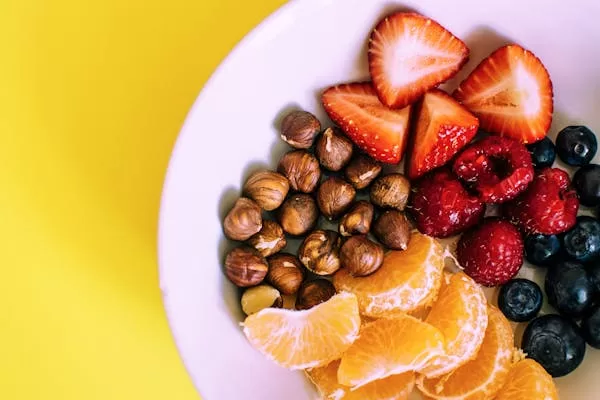
How Does Diet Affect Common Skin Problems Like Acne, Psoriasis, and Eczema?
Skin issues such as acne, psoriasis, and eczema can be influenced by various factors, including diet. Let’s explore how what you eat can impact these conditions and what changes you might consider.
Acne and Dietary Connections
Acne often arises from hormonal changes, particularly during puberty and peri-menopause. These hormonal shifts can lead to overactive oil glands and cause skin inflammation.
To potentially reduce acne, consider these dietary adjustments:
- Limit Fats: Reduce intake of saturated and hydrogenated fats usually found in margarine and processed foods.
- Avoid Sugary Foods: Steer clear of sugary treats like cakes and cookies.
- Embrace Whole Foods: Increase your intake of raw vegetables, whole grains, fresh fruits, and fish.
- Boost Selenium Intake: Incorporate selenium-rich foods such as Brazil nuts, cashews, tuna, sunflower seeds, walnuts, and whole grain bread.
- Adopt a Mediterranean Diet: This eating style, rich in fruits, vegetables, and healthy fats, may decrease acne severity.
Psoriasis and Nutritional Influence
Psoriasis manifests as red, scaly patches, typically on the elbows and knees. This condition results from rapid skin cell turnover and can be aggravated by factors like sunburn, alcohol, smoking, obesity, and stress. Specific dietary triggers might exist and can be identified with the help of a registered dietitian.
Consider the following dietary modifications:
- Reduce Saturated Fats: Particularly from red and processed meats.
- Focus on Omega-3s: Introduce more oily fish and high-quality nut and seed oils into your diet.
- Incorporate Anti-Inflammatory Foods: Use herbs and spices like turmeric, ginger, cumin, fennel, rosemary, and garlic to naturally curtail inflammation.
Eczema and Food Sensitivities
Eczema is characterized by itchy, red patches, potentially triggered by food sensitivities. Consulting with a healthcare provider or registered dietitian can be beneficial in identifying problematic foods through an exclusion diet.
Common food culprits might include:
- Dairy products
- Eggs
- Fish
- Nuts
- Various food additives
To support skin health and manage symptoms, it’s wise to include foods high in omega-3 fatty acids, zinc, and vitamin E in your diet.
By making thoughtful food choices, you can positively influence these common skin problems and potentially alleviate some of their symptoms. Always seek professional guidance when making significant dietary changes, especially for managing health conditions.
Achieving Fabulous Skin Through Nutrition
Looking to achieve glowing, fabulous skin? Start by nourishing it from the inside out! The key lies in supporting your skin’s natural renewal process with the right nutrients, ensuring it remains soft, supple, and blemish-free.
1. Feed Your Skin with Nutrients
Your skin is constantly regenerating, with older cells being replaced by new ones. Providing a continuous supply of essential nutrients is crucial for this turnover:
- Antioxidant-Rich Foods: Incorporate plenty of fruits and vegetables rich in antioxidants, like berries, spinach, and carrots. Antioxidants help protect your skin from the harmful effects of environmental stressors.
- Healthy Fats: Quality fats from sources such as oily fish (like salmon and mackerel) and nuts (almonds and walnuts) contribute to maintaining the skin’s elasticity and hydration.
- Hydration: Never underestimate the power of water. Proper hydration aids in flushing out toxins and keeping your skin looking fresh and dewy.
2. Minimize Damage
While some signs of aging, like wrinkles and age spots, are natural, you can still take steps to minimize additional damage:
- Sun Protection: Limit exposure to the sun and tanning beds to prevent premature aging.
- Gentle Products: Use mild skincare products to avoid further irritation or damage.
3. Balance Your Diet for Optimal Skin Health
A balanced diet rich in vitamins, minerals, and healthy fats isn’t just good for your general health—it’s vital for your skin too. By fine-tuning your nutritional intake, you’re setting a strong foundation for healthier skin that radiates from within.
A fabulous complexion starts with smart dietary choices that empower your skin to be its very best. So, fill your plate with these nourishing foods and watch your skin thrive!
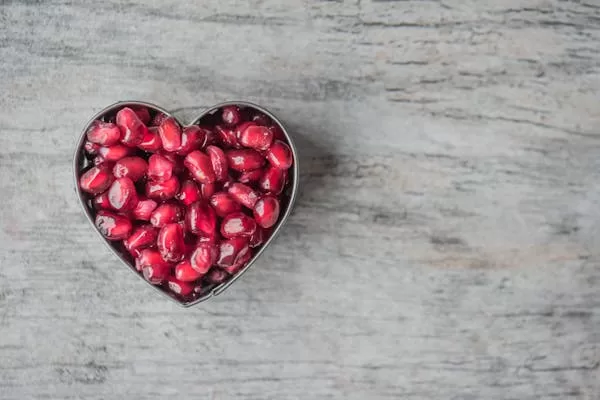
Understanding Low-GI Carbs and Their Skin Benefits
What Are Low-GI Carbs?
The glycaemic index (GI) is a ranking system for carbohydrates that measures how quickly they convert to glucose in the body. Low-GI carbs are those that break down slowly, ensuring a gradual release of energy. Foods such as beans, lentils, whole grains, and oats fall into this category. These carbohydrates provide a steady energy supply, keeping you full longer and reducing the temptation to snack.
How Do Low-GI Carbs Benefit the Skin?
Consuming low-GI carbohydrates can have a positive effect on skin health. Here’s why:
- Stable Insulin Levels: Low-GI foods prevent rapid increase in blood sugar levels, which means less insulin production. High levels of insulin can lead to increased inflammation and collagen damage, accelerating the aging process and the formation of wrinkles.
- Hydration and Skin Elasticity: Low-GI foods often contain fiber and essential nutrients that support skin hydration and maintain elasticity, promoting a youthful appearance.
- Sustained Energy for Skin Repair: The gradual energy release from low-GI carbs supports your body’s repair processes, including skin repair. This steady energy supply enables the skin to better protect and renew itself.
Tips for Incorporating Low-GI Carbs Into Your Diet
- Opt for breakfasts like porridge garnished with fruits like blueberries, which are rich in antioxidants.
- Enjoy salads with ingredients such as beans and asparagus, which not only offer protein and fiber but also enhance your skin’s nutrition.
By choosing low-GI carbohydrates, you’re not only managing your energy levels but also taking a proactive step towards healthier, more resilient skin.
Understanding the Impact of Diet on Eczema
Eczema often manifests as red, inflamed patches on the skin and can appear anywhere, though the hands are a common site. While various triggers can exacerbate this condition, food sensitivities are among the most prevalent.
Athlete’s Diet: Foods That May Trigger Eczema
Identifying which foods could provoke eczema symptoms is crucial. Common culprits include:
- Dairy Products: Milk and cheese can sometimes trigger reactions.
- Eggs: Known for their allergy potential, they can be problematic for some.
- Seafood: Fish and shellfish may lead to flare-ups.
- Nuts: Especially peanuts are known allergens.
- Food Additives: Preservatives and artificial colorings might irritate sensitive skins.
Implementing Dietary Changes
Before making any dietary changes, it’s essential to consult a healthcare professional, such as a registered dietitian. An exclusion diet, which involves removing suspected foods and gradually reintroducing them, might help pinpoint specific triggers.
Eczema-Soothing Foods
To mitigate eczema symptoms, incorporating certain nutrients into your diet can be beneficial:
- Omega-3 Fatty Acids: Found in fish like salmon and flaxseeds, these can help reduce inflammation.
- Zinc-Rich Foods: Include beef, seeds, and chickpeas in your meals for their skin-healing properties.
- Vitamin E Sources: Opt for nuts, seeds, and spinach to support skin health.
Balancing your diet with these considerations can potentially ease the severity of eczema symptoms, leading to healthier, more comfortable skin.

Why is it Essential to Consume at Least Five Portions of Fruits and Vegetables Daily for Skin Health?
Maintaining radiant and healthy skin requires more than just topical treatments. The secret often lies in what you eat. Consuming at least five portions of fruits and vegetables daily can play a crucial role in promoting vibrant skin. Here’s why:
Antioxidant Powerhouses
Fruits and vegetables are abundant in antioxidants, crucial compounds that help shield your skin from damage. These antioxidants combat free radicals—unstable molecules generated by factors like pollution, smoking, and UV exposure—that can lead to premature skin aging and deterioration. By neutralizing these free radicals, antioxidants protect your skin at the cellular level.
The Beauty of a Rainbow Diet
Incorporating a variety of colorful fruits and vegetables into your diet ensures you’re getting a diverse spectrum of nutrients. Consider the vibrant hues of nature on your plate:
- Orange and Yellow Produce: Carrots, sweet potatoes, and pumpkins are loaded with beta-carotene, which is vital for skin cell development and maintaining a healthy complexion.
- Green Veggies: Kale, spinach, and papaya are rich in lutein, known to enhance skin tone and resilience.
Nutrient Density
A diet rich in different fruits and vegetables provides a plethora of vitamins and minerals, each contributing to skin health. From vitamin C, which fosters collagen production, to vitamin E, which supports skin repair, these nutrients work synergistically to keep your skin plump and youthful.
Conclusion
Incorporating a minimum of five portions of diverse fruits and vegetables each day not only brings you one step closer to that glowing skin but also enriches your overall health. Remember, your skin is a reflection of what you nourish your body with; fill your plate with nature’s best to see the difference.
How Zinc Enhances Skin Health
Zinc plays a crucial role in maintaining skin health by ensuring the proper function of oil-producing glands. This mineral supports skin suppleness and is vital in the healing process, aiding in the repair of skin damage. It helps balance natural skin oils and promotes a clear complexion.
Athlete’s Diet: Foods High in Zinc
To take advantage of zinc’s skin-enhancing benefits, incorporate these zinc-rich foods into your diet:
- Fish: A versatile source, offering more than just omega-3 fatty acids.
- Lean Red Meat: Provides a good amount of zinc along with essential proteins.
- Whole Grains: Such as oats and quinoa, which deliver zinc with fiber for digestive benefits.
- Poultry: Chicken and turkey are excellent sources.
- Nuts and Seeds: Almonds, pumpkin seeds, and sunflower seeds can boost your zinc intake.
- Shellfish: Oysters and crabs are particularly high in zinc.
Including these foods in your meals can help support healthier, more radiant skin.
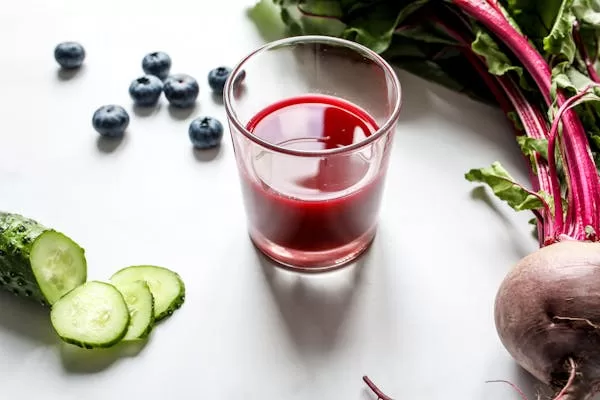
What Are Phyto-estrogens, and How Do They Affect Skin Health?
Phyto-estrogens are natural compounds found in a variety of plants, and they mimic the structure of the female hormone estrogen. These compounds are crucial because they help maintain hormonal balance, which in turn supports skin health. Estrogen has a significant role in maintaining skin’s structure and minimizing damage, which makes phyto-estrogens beneficial for achieving a healthy complexion.
Types of Phyto-estrogens
- Isoflavones: Predominantly found in soy products like tofu and tempeh, isoflavones are well-known phyto-estrogens that have been studied for their skin health benefits.
- Lignans: These are present in the fiber of whole grains, as well as in fruits, vegetables, and flaxseed. Lignans also contribute to hormone balance and are advantageous for skin wellness.
How Phyto-estrogens Affect Skin
By mimicking estrogen, phyto-estrogens can help support the skin’s structural integrity. They work towards reducing skin damage and may even have anti-aging effects owing to their ability to maintain collagen levels and skin elasticity. This makes them a valuable part of a diet focused on keeping your skin youthful and resilient.
Incorporating phyto-estrogen-rich foods like soy and flaxseed into your meals could be a straightforward way to harness these benefits. By doing so, you not only support hormonal balance but also give your skin the nutrients it needs for optimal health.
Understanding the Function of the Skin as an Organ
The skin, often referred to as the body’s largest organ, plays several crucial roles that are vital for our overall health and well-being.
Key Functions of the Skin:
- Protection: Acting as a formidable shield, the skin defends against environmental hazards, such as bacteria, viruses, and harmful UV radiation. It also provides a barrier to prevent the loss of necessary bodily fluids.
- Temperature Regulation: Through processes like sweating and blood vessel dilation or constriction, the skin helps maintain a stable internal temperature, ensuring the body’s systems function optimally.
- Sensation: Packed with nerve endings, the skin allows us to feel touch, pressure, pain, and temperature changes. This sensory capability helps us interact with our environment and react swiftly to avoid harm.
- Immune Defense: The skin is equipped with specialized cells that detect invasive threats and trigger an immune response, protecting the body from potential infections.
- Vitamin D Synthesis: Exposure to sunlight enables the skin to produce vitamin D, essential for bone health and numerous other bodily functions.
The health and appearance of the skin are influenced by a variety of factors, including genetic predispositions, age, hormonal shifts, medical conditions like diabetes, and one’s diet and lifestyle choices. Each of these elements can affect how skin performs its myriad of vital functions.
2. Improved Muscle Recovery and Strength
- Key Elements: Protein-rich foods in an athlete’s diet accelerate muscle recovery after intense workouts.
- Performance Boost: Carbohydrates in the diet restore glycogen levels, fueling the body for subsequent workouts and helping to prevent muscle fatigue.
3. Sustained Energy and Endurance
- Complex Carbohydrates: Slow-digesting carbs provide consistent energy and avoid the mid-day slump.
- Optimal Hydration: Electrolyte balance is critical to staying energized and maintaining skin hydration.

HOLY Hydration ‘Strawberry Kiwi’ 50 portions with Valuable Electrolytes & Minerals
How Much Water Should You Drink Daily for Optimal Skin Hydration?
To maintain skin’s natural suppleness and vitality, it is essential to keep it well-hydrated. Dehydration, even at a mild level, can make your skin appear dry and fatigued. It may even give your complexion a lackluster, dull tone.
Recommended Daily Water Intake
Experts suggest aiming for six to eight glasses of water each day. This guideline helps ensure that your body and skin receive adequate hydration. While all fluids contribute to your overall intake, plain water remains the most effective choice for hydrating your skin.
Staying hydrated can greatly enhance the appearance and health of your skin, making it look smoother and more vibrant. By consistently meeting this hydration target, you can support your skin’s natural functions and aesthetic appeal.
Step-by-Step Guide to Building an Athlete’s Diet
Step1: Determine Caloric Needs
- Assessing Activity Level: Active individuals require higher calories to meet their energy expenditure.
- Tip: Use a caloric calculator or consult a nutritionist to get a precise number.
Step 2: Set Up Macronutrient Ratios
- Carbohydrates (50-60%): Essential for energy; opt for whole grains and fruits.
- Proteins (15-25%): Focus on lean proteins for muscle repair, such as fish, chicken, and legumes.
- Fats (20-30%): Healthy fats are crucial for skin elasticity and hormone balance. Certain fats act as natural moisturizers, keeping your skin supple from the inside while improving elasticity. These include monounsaturated and polyunsaturated fats found in avocados, oily fish, nuts, and seeds.
- These beneficial fats come with a healthy dose of vitamin E, enhancing their skin-nourishing properties. Pay particular attention to omega-3 fatty acids, a type of polyunsaturated fat. They’re anti-inflammatory and can help alleviate skin conditions like eczema and psoriasis. Moreover, they form the building blocks of healthy skin.
- Key Sources of Omega-3 Fatty Acids:
- Oily fish: salmon, trout, and sardines
- Plant sources: flaxseed, chia seeds, walnuts, and rapeseed oil
- Incorporating these fats into your diet not only supports skin health but also contributes to overall well-being.
Step 3: Time Meals for Maximum Impact
- Pre-Workout Fuel: Carbs and light protein 1-2 hours before training.
- Post-Workout Recovery: Protein with carbs within 30 minutes after a workout for optimal muscle recovery.
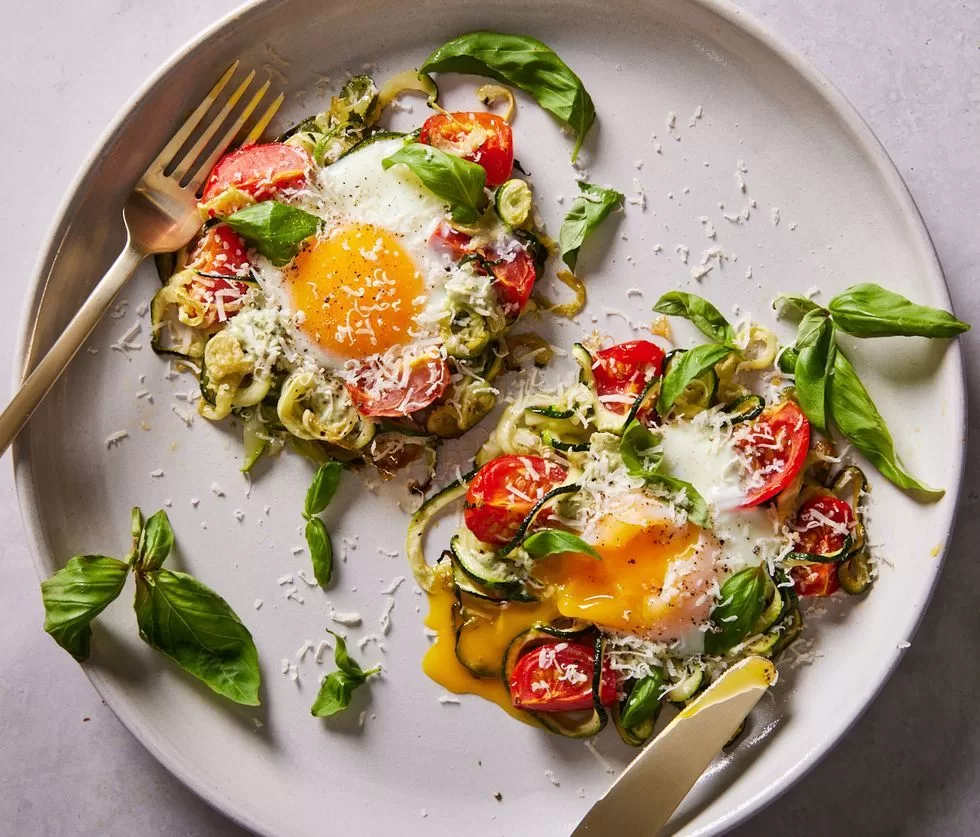
Deliciously Quick Keto Breakfast Recipes: Nutritious and Easy to Make
Essential Nutrients for Skin and Athletic Performance
| Nutrient | Benefits for Skin | Benefits for Fitness | Sources |
|---|---|---|---|
| Vitamin C | Reduces inflammation, boosts collagen production | Reduces muscle soreness | Oranges, strawberries, bell peppers |
| Protein | Supports skin repair | Builds and repairs muscle | Chicken, tofu, Greek yogurt |
| Omega-3 | Improves skin elasticity | Reduces inflammation | Salmon, walnuts, chia seeds |
| Carbohydrates | Hydrates skin cells | Main energy source | Brown rice, oats, sweet potatoes |
| Vitamin E | Protects against UV damage | Aids in endurance | Almonds, sunflower seeds, spinach |
These research-based nutrients have been shown to optimize both skin health and athletic performance, making them ideal additions to any diet aiming for radiant skin and peak fitness.

Pumpkin Seeds Take the Crown as the Healthiest Seed
Dietary Changes to Help Minimize Acne
Addressing acne often begins with reevaluating dietary habits. Here are some effective changes you can make:
- Reduce Unhealthy Fats
Steer clear of foods high in saturated and hydrogenated fats. These are commonly found in many margarines and processed items. - Limit Sugar and Junk Food
Cut out junk food and reduce your intake of sugary treats like cakes and cookies. High sugar content can trigger acne flare-ups. - Increase Raw and Whole Foods
Boost your consumption of raw vegetables, whole grains, fresh fruits, and fish. These foods are rich in nutrients and support clearer skin. - Incorporate Selenium-Rich Foods
Integrate selenium-packed foods into your diet. Consider nuts such as Brazil and cashew nuts, as well as sunflower seeds, walnuts, fresh tuna, and wholemeal bread. - Adopt a Mediterranean Diet
The Mediterranean diet, which emphasizes fruits, vegetables, whole grains, and healthy fats, has been associated with reduced acne severity. Adopting this style of eating may offer significant benefits for those prone to acne.
By making these changes, you can take a proactive step towards clearer skin. Remember, it’s always best to consult with a healthcare professional for personalized dietary advice.
How Zinc Enhances Skin Health
Zinc plays a crucial role in maintaining skin health by ensuring the proper function of oil-producing glands. This mineral supports skin suppleness and is vital in the healing process, aiding in the repair of skin damage. It helps balance natural skin oils and promotes a clear complexion.
Athlete’s Diet: Foods High in Zinc
To take advantage of zinc’s skin-enhancing benefits, incorporate these zinc-rich foods into your diet:
- Fish: A versatile source, offering more than just omega-3 fatty acids.
- Lean Red Meat: Provides a good amount of zinc along with essential proteins.
- Whole Grains: Such as oats and quinoa, which deliver zinc with fiber for digestive benefits.
- Poultry: Chicken and turkey are excellent sources.
- Nuts and Seeds: Almonds, pumpkin seeds, and sunflower seeds can boost your zinc intake.
- Shellfish: Oysters and crabs are particularly high in zinc.
Including these foods in your meals can help support healthier, more radiant skin.
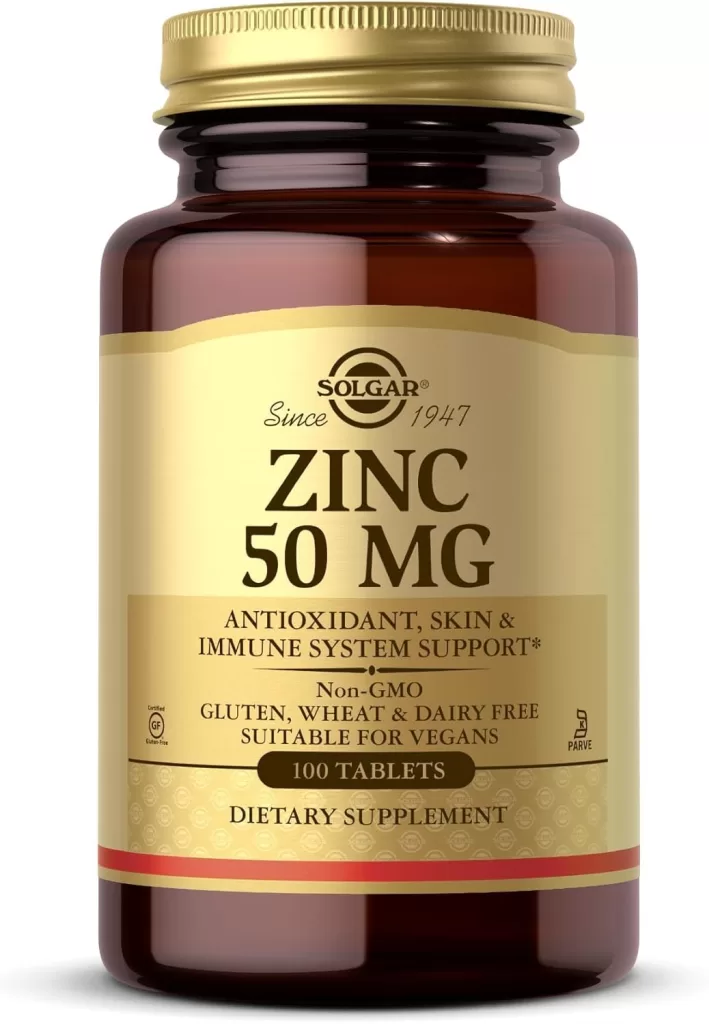
Solgar Zinc 50 mg Tablets – Pack of 100 – Supports a Healthy Immune System – Potent Antioxidant – Free from Sugar, Salt and Starch – Vegan
The Role of Selenium in Skin Health
Selenium is a vital antioxidant that significantly contributes to maintaining skin health. By working synergistically with vitamins C and E, selenium helps to protect the skin against various forms of damage. It plays a crucial role in shielding the skin from the harmful effects of sun exposure and may reduce the risk of skin cancer. Additionally, selenium can aid in preventing the formation of age spots, promoting a youthful and healthy complexion.
Boosting Selenium in Your Diet
Incorporating selenium-rich foods into your diet is a straightforward way to reap its skin-protective benefits. Here are some excellent sources:
- Brazil Nuts: Just two to three Brazil nuts can meet your daily selenium requirement.
- Fish and Shellfish: These are not only good for their selenium content but also boost your omega-3 intake.
- Eggs: A versatile addition to your diet that brings more than just selenium.
- Wheatgerm: A nutritious choice to sprinkle over cereals or incorporate into baking.
- Vegetables: Tomatoes and broccoli are both readily accessible and nutritious sources.
For an energizing snack, try mixing Brazil nuts with seeds high in vitamin E. This combination not only enhances selenium intake but also maximizes the synergistic benefits with vitamin E, enhancing skin health and glowing appearance.
Athlete’s Diet: Sample Meal Plan
Below is a dermatologist- and nutritionist-approved meal plan focusing on skin health and athletic performance.
| Meal | Food Items |
|---|---|
| Breakfast | Oatmeal with chia seeds, blueberries, and Greek yogurt |
| Mid-Morning | Whole-grain toast with avocado and smoked salmon |
| Lunch | Grilled chicken, quinoa, and steamed spinach with a drizzle of olive oil |
| Afternoon Snack | Cottage cheese with sliced pineapple and a handful of almonds |
| Dinner | Baked salmon with sweet potato and roasted asparagus |
| Post-Workout | Protein smoothie with banana, almond milk, and a scoop of whey protein |
This meal plan not only provides sustained energy but also incorporates foods known to support skin and muscle recovery.

How to Lose 7lbs/3kgs in 3 Weeks: Effective Diet and Exercise Strategies
Frequently Asked Questions
What are the benefits of an athlete’s diet for skin?
Athlete diets are high in nutrients that improve skin hydration, reduce inflammation, and support overall radiance.
How does an athlete’s diet support muscle recovery?
The protein content aids in muscle repair, while carbohydrates restore glycogen, giving the body the energy needed for recovery and next-day training.
Are there any dermatologist-approved foods for radiant skin?
Yes! Foods rich in antioxidants, such as berries, leafy greens, and nuts, are dermatologist-approved for supporting skin health and reducing signs of aging.
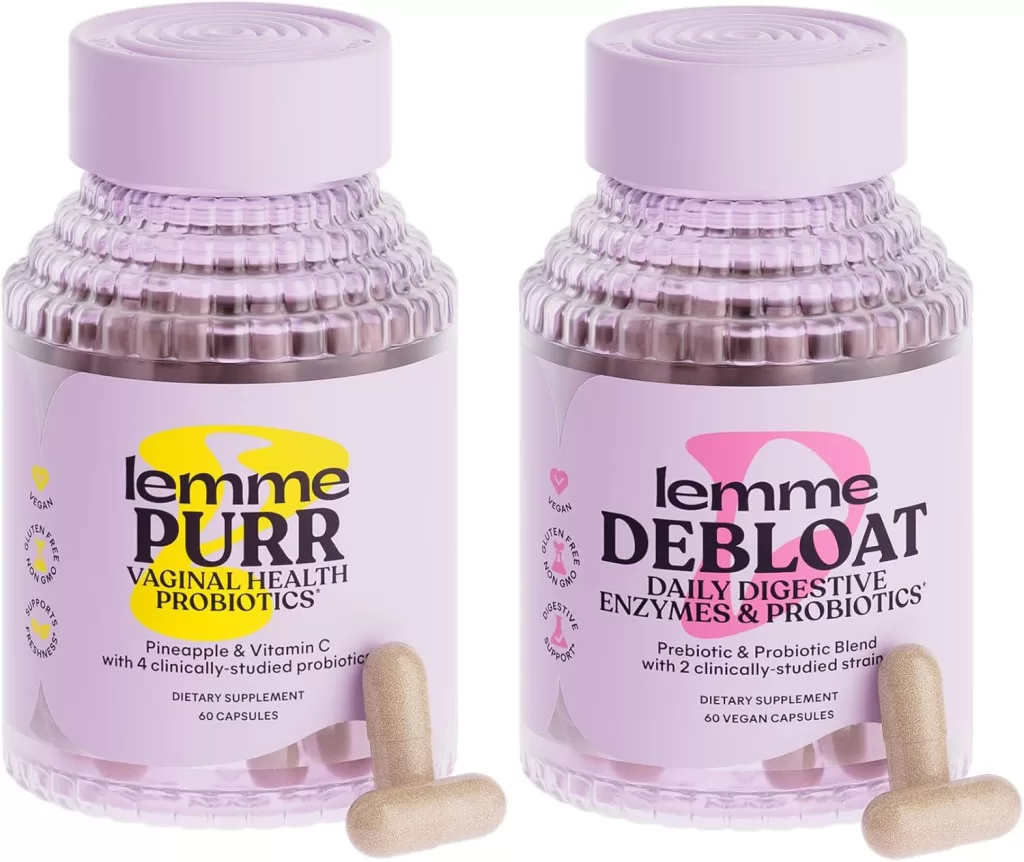
Unlocking the Benefits of Lemme Purr Gummies
Key Considerations for Dietary Changes to Improve Skin Health
When thinking about adjusting your diet to enhance skin health, it’s important to approach these changes with well-informed steps:
- Consult Healthcare Professionals
Before embarking on any dietary changes, it’s crucial to seek advice from healthcare professionals. Speak to your general practitioner (GP) or a registered dietitian. They can provide personalized guidance, taking your unique health conditions and nutritional needs into account. - Understand Your Skin Condition
For chronic skin issues, it’s beneficial to have a conversation with your GP about your symptoms. If necessary, they may recommend seeing a dermatologist who can accurately diagnose your condition and suggest appropriate treatment, which may include dietary adjustments. - Review Nutritional Needs
Tailor your dietary changes to include foods that support skin health, such as those rich in vitamins A, C, and E, omega-3 fatty acids, and antioxidants. However, make these adjustments with professional guidance to ensure you’re meeting all your nutritional requirements. - Consider Potential Food Sensitivities
If considering an exclusion diet (eliminating certain foods to see if they affect skin health), it’s especially important to do so under professional supervision. This approach can help identify potential food irritants or allergens without compromising overall nutrition. - Evaluate Lifestyle Factors
Skin health is influenced by more than just diet. Consider other lifestyle factors like stress, hydration, sleep, and overall skin care routine, as these can also play significant roles in skin appearance and health.
By taking these thoughtful steps, you’ll be better equipped to make informed choices that support your skin’s vitality and overall well-being.
What Dietary Considerations Are Suggested for Managing Psoriasis?
Psoriasis, a skin condition marked by red, scaly patches, often points to diet as a potential trigger. While several lifestyle factors like sun exposure, smoking, and stress contribute to its flare-ups, dietary choices also play a significant role.
Foods to Limit
- Saturated Fats: Reduce your intake of saturated fats found in red and processed meats. These fats may exacerbate inflammation and worsen symptoms.
- Alcohol: Minimize alcohol consumption, as it can potentially worsen psoriasis.
Foods to Include
- Healthy Fats: Embrace healthy fats, particularly omega-3 fatty acids. Nutrient-rich sources like oily fish (e.g., salmon, mackerel) and cold-pressed oils (such as flaxseed or walnut oil) are excellent choices.
- Anti-Inflammatory Herbs and Spices: Integrate anti-inflammatory ingredients like turmeric, ginger, and cumin into your meals. These spices can help reduce inflammation and are a flavorful addition to any dish.
Important Note
While dietary changes can make a difference, they should be approached with care. An exclusion diet might help identify specific trigger foods, but it should only be undertaken with professional guidance. Consult with a registered dietitian and discuss potential referrals with your healthcare provider to tailor a plan that suits your individual needs.
Effective dietary management can be a crucial part of living with psoriasis, helping to alleviate symptoms and improve overall well-being.
Conclusion: Athlete’s Diet
An athlete’s diet goes beyond fitness, supporting radiant skin and overall health. Whether you’re aiming to unlock a flawless complexion or achieve peak performance, this nutrition plan is a scientifically backed approach to becoming the best version of yourself. Discover the perfect balance of nutrients and transform your skincare and fitness routine with every meal.
Related Article:

How to Lose 7lbs/3kgs in 3 Weeks: Effective Diet and Exercise Strategies

THE Best Peter Thomas Roth – Pore Putty Pore and Wrinkle Reducer 1 Fl Oz New by Peter Thomas Roth
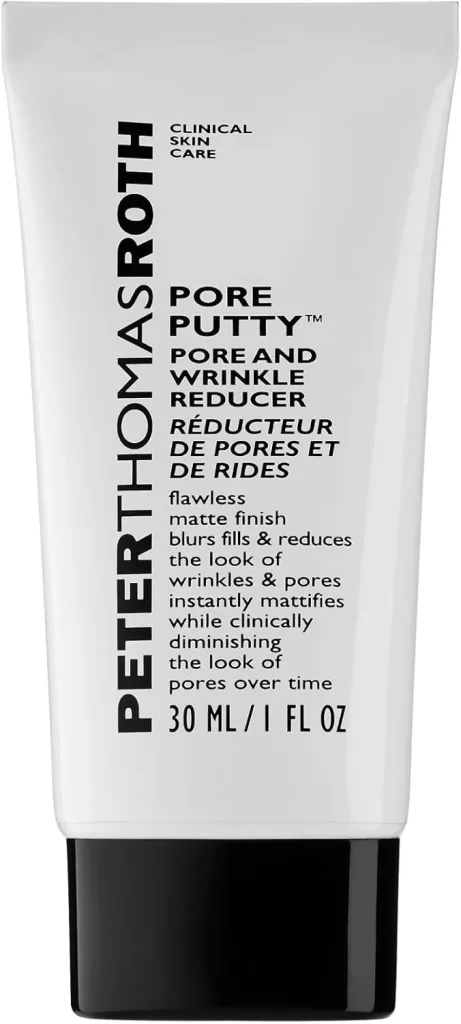
Explore more articles like this @ Where And How Resources
If you found this article helpful, don’t forget to share it with your friends and followers!

